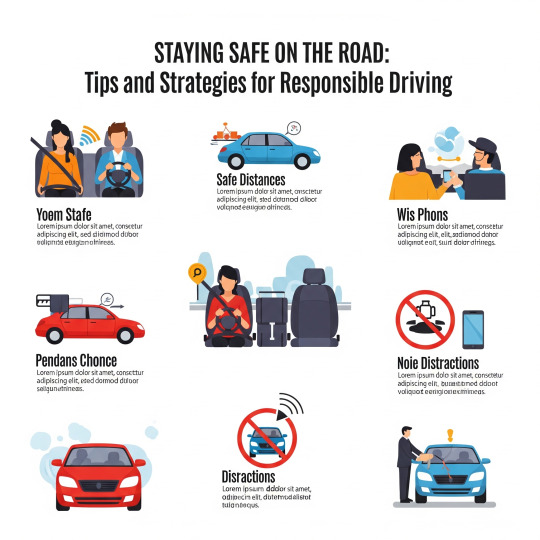#DrivingTips
Explore tagged Tumblr posts
Text
Top Cultural Differences About Driving Newcomers Notice in Canada
Driving in Canada can be a unique experience for newcomers, especially if they come from countries with different driving cultures. Here are some of the key cultural differences about driving in Canada that newcomers often notice when they first hit the road.
1. Strict Adherence to Traffic Laws
What Newcomers Notice: Canada is known for its strict enforcement of traffic laws. Whether it's speed limits, seat belt usage, or pedestrian rights, drivers must obey the rules carefully.
Why It’s Different: In some countries, there might be more leniency in how traffic laws are enforced. However, in Canada, police regularly monitor for violations, and fines can be hefty for not complying with the rules.
2. Winter Driving and Road Safety
What Newcomers Notice: Canadian winters are notorious for harsh driving conditions like snow, ice, and freezing rain. Many drivers use winter tires from November to April, and roads are often plowed frequently.
Why It’s Different: In warmer countries, winter driving may not be a concern. Newcomers from tropical or milder climates may need time to adjust to winter road conditions and the importance of maintaining safe distances in snowy or icy weather.
3. Pedestrian Priority
What Newcomers Notice: Pedestrian safety is a high priority in Canada, and drivers are expected to yield to pedestrians at crosswalks. In busy urban areas, you’ll notice pedestrian signals and crosswalks that drivers must respect.
Why It’s Different: In some countries, pedestrian rights at crosswalks might not be as strictly enforced, or pedestrians may not have designated crosswalks as frequently. Newcomers may be surprised at how quickly Canadian drivers stop for pedestrians.
4. The Use of Turn Signals
What Newcomers Notice: In Canada, using turn signals is not just a recommendation—it's a legal requirement. Whether you're changing lanes, turning, or merging, signaling your intentions is expected at all times.
Why It’s Different: In some countries, the use of turn signals might not be as consistent, and drivers may change lanes or turn without signaling. This is often a cultural habit that takes time for newcomers to adopt.
5. Roundabouts and Traffic Circles
What Newcomers Notice: Roundabouts or traffic circles are commonly found in Canadian cities, and many new drivers find them confusing at first. Understanding the right-of-way and the rules for entering and exiting these circular intersections is crucial.
Why It’s Different: Roundabouts might be less common or structured differently in other countries. In countries with heavy traffic, traffic signals or stop signs might govern intersections more frequently.
6. Drive-Thru Culture
What Newcomers Notice: Canada has a popular drive-thru culture for everything from fast food and coffee to banking services and pharmacies. The convenience of staying in your vehicle is part of Canadian life.
Why It’s Different: In many countries, drive-thru services are less common, and people are accustomed to walking into stores or businesses for services. This level of convenience may be a novel experience for newcomers.
7. Highway Driving Etiquette
What Newcomers Notice: On highways and interprovincial roads, Canadian drivers typically follow a keep-right rule unless they are overtaking another vehicle. It's also common for drivers to yield to faster-moving traffic on highways, ensuring smoother travel.
Why It’s Different: In some countries, lanes may be less strictly regulated, and overtaking might not follow a specific rule. In contrast, Canada emphasizes orderliness in high-traffic zones, and lane discipline is a significant cultural norm.
8. The Importance of Emergency Vehicle Right-of-Way
What Newcomers Notice: In Canada, when an emergency vehicle (like an ambulance, fire truck, or police car) approaches with sirens on, drivers are legally required to pull over to the right and stop, allowing the vehicle to pass quickly.
Why It’s Different: In many countries, drivers may not be as quick to yield to emergency vehicles, and emergency vehicles may not have the same priority in traffic. In Canada, this is a critical safety rule that's closely adhered to.
9. The Dangers of Distracted Driving
What Newcomers Notice: Canada has strict distracted driving laws, including fines for using cell phones while driving unless hands-free devices are used. This includes texting, calling, or even holding a phone while driving.
Why It’s Different: In some countries, there may be less enforcement of distracted driving laws, or the use of phones might be more common. In Canada, however, the penalties are severe, and the importance of focusing on the road is a central value.
10. Driving Age and Licensing Process
What Newcomers Notice: The gradual licensing system (such as G1, G2, and G) is standard in Canada. Newcomers may also notice that obtaining a driver’s license involves more steps, including written exams, driving tests, and sometimes a graduated license period.
Why It’s Different: In some countries, the licensing process may be more straightforward, with fewer steps or less time between stages of licensing. Canada’s focus on road safety leads to a longer, more thorough process.
11. The Emphasis on Seat Belts
What Newcomers Notice: In Canada, it’s mandatory for everyone in the vehicle—both the driver and passengers—to wear seat belts at all times, regardless of where they sit in the car.
Why It’s Different: In some countries, seat belt usage might not be as rigorously enforced, or there may be fewer regulations around seat belt laws for rear-seat passengers. Guide your teen's journey with help from licenseprep.ca.
#DrivingInCanada#NewcomerDriving#CulturalDifferences#CanadianRoads#DrivingTips#CanadianDrivers#DrivingCulture#RoadSafetyCanada#NewDrivers
6 notes
·
View notes
Text
Top Mistakes to Avoid on the Driving Test

Introduction Many test-takers fail because of preventable mistakes. Learn what to avoid so you can pass confidently.
Mistakes to Watch Out For
Rolling Stops : Always come to a full stop at stop signs. Count to 2 before proceeding.
Failure to Check Blind Spots : Use your mirrors, check your blind spot, and signal properly.
Speeding or Driving Too Slowly : Going too fast or too slow can both be penalized. Match the speed limit closely.
Not Obeying Traffic Signs
Tip: Record Practice Drives Reviewing footage of your practice can help you catch bad habits. Review rules at licenseprep.ca before the test.
4 notes
·
View notes
Text
I’m from MA…it’s as if nobody knows they have a blink ah!🤣🤣drives me crazy!
in case you needed to hear it today:
it’s okay to use your turn signal when you’re changing lanes
it’s okay to use your turn signal when you’re taking an exit
it’s okay to use your turn signal when you plan on turning (can even be done sooner than 2 seconds before you’re about to turn)
you have a turn signal. in your vehicle. two of them in fact.
you are so brave and beautiful and smart and can do it. using your turn signal
112K notes
·
View notes
Text
Staying Safe on the Road: Tips and Strategies for Responsible Driving

Staying Safe on the Road: Tips and Strategies for Responsible Driving
Road safety is a shared responsibility. Whether you're an experienced driver or just got your license, adopting safe driving habits not only protects your life but also the lives of others on the road. In today’s world, with increasing traffic and distractions, staying alert and practising responsible driving is more important than ever.
Here are key tips and strategies to help you stay safe behind the wheel—and ensure your vehicle stays in top condition with quality components like UNO Minda spare parts.
Stay Focused and Avoid Distractions Distractions are among the leading causes of road accidents. Whether it's using a mobile phone, adjusting the radio, or eating while driving, every second your eyes are off the road increases the risk. Use hands-free devices if necessary and always keep your focus on driving.
Maintain Your Vehicle Regularly Safe driving starts with a well-maintained vehicle. Ensure your brakes, lights, tires, and engine are in optimal condition. Using genuine components such as UNO Minda spare parts ensures your vehicle’s performance and safety systems function reliably. Uno Minda is known for manufacturing high-quality automotive components, from lighting and horns to switches and sensors, which can greatly enhance your driving experience and safety.
Obey Traffic Rules This one might sound obvious, but many drivers ignore basic traffic rules. Always follow speed limits, signal before turning, and respect traffic signals. Being a responsible driver means anticipating other drivers’ actions and reacting in a calm, lawful manner.
Don’t Drive Under the Influence Alcohol, drugs, and certain medications can impair your judgment and reaction time. If you're under the influence, call a cab, use public transport, or let a sober friend drive. It’s a simple decision that can save lives.
Keep a Safe Distance Tailgating is dangerous. Maintain a safe following distance from the vehicle in front of you. This gives you enough time to react if the vehicle suddenly stops or slows down.
Use Safety Features Wisely Modern vehicles come equipped with advanced safety features like ABS, airbags, and rear-view cameras. But they only help if they're in working condition and used correctly. Here again, using high-quality components like those from Uno Minda ensures that your safety systems function as intended, offering peace of mind during every journey.
Be Weather-Wise Rain, fog, or snow can reduce visibility and road grip. In such conditions, slow down, turn on your headlights, and drive with extra caution. Check your wipers, defrosters, and lights regularly—components often available from trusted suppliers like UNO Minda.
Conclusion Safe driving is not just about getting from point A to point B—it's about making thoughtful decisions that protect everyone on the road. Routine maintenance using reliable products like UNO Minda spare parts and adopting responsible driving behaviours go hand-in-hand in creating a safer driving environment. So buckle up, stay focused, and drive smart.
Because safety isn’t just a destination—it’s the whole journey.
#RoadSafety#ResponsibleDriving#DrivingTips#StaySafe#DefensiveDriving#SafeDriving#VehicleSafety#DriveSmart#TrafficRules#DriveSafeSaveLives#RoadAwareness#CarTips#TumblrBlogs#AutoLifestyle
0 notes
Text
⚙️ Automatic Driving Lessons
These are all about learning to drive an automatic car (no clutch, no gear shifting — just gas and brake). Ideal for:
Beginners who want an easier start 🚦
People who don’t want to deal with manual gears
Drivers looking for a smoother, stress-free experience
💡 What You Learn:
How to operate an automatic car safely
Road rules, basic driving techniques
Parking, turning, merging — all without gear-related stress
✅ Simple. Smooth. Beginner-friendly.
0 notes
Text
Windscreen Making Noise While on the Road? Find Out Why!

Is your windscreen making annoying noises while driving? Discover the causes - loose seals, cracks, or poor installation - and learn when it's time for a fix or replacement to enjoy a quieter, safer ride.
Visit: https://www.a1windscreens.com.au/blog/why-is-the-windscreen-making-noise-while-driving
#WindscreenNoise#AutoGlassRepair#NoisyWindscreen#CarMaintenance#DrivingTips#WindscreenReplacement#CarCare#A1Windscreens#WindscreendFix#RoadSafety
0 notes
Text

Struggling to attract more students to your driving school? Our platform is here to help you generate leads and secure more bookings effortlessly!
Are you finding it tough to fill your driving school schedule? You’re not alone. Many driving instructors face the same challenge: getting more students through the door. In today’s competitive landscape, just being a great teacher isn’t enough—you need a steady stream of leads and a system that turns interest into confirmed bookings.
Download the local needs app
visit our site : www.localneeds.live
#DrivingSchool#LearnToDrive#DrivingLessons#DriverTraining#DrivingInstructor#DrivingTips#DriveSafe#MoreStudents#getmoreleads#IncreaseBookings#bestdrivingschool#localdrivingschool#localneeds#GooglePlayStore#downloadtheappnow
0 notes
Text
The Rise of Virtual Driving Lessons in Canada: Do They Work?

The world of driver education in Canada is evolving rapidly with the rise of virtual driving lessons. Thanks to advances in technology and the recent push for remote learning options, many aspiring drivers are turning to online platforms to prepare for their driving tests. But the question remains: do virtual driving lessons really work?
What Are Virtual Driving Lessons?
Virtual driving lessons use video calls, simulators, and online resources to teach the theory and practical knowledge required for driving. These lessons often include modules on traffic rules, road signs, hazard perception, and even simulated driving experiences. They allow learners to study at their own pace, from the comfort of their home.
Benefits of Virtual Driving Lessons
Flexibility: Learners can schedule sessions around their busy lives without the need to commute.
Cost-Effective: Virtual lessons often cost less than traditional in-car instruction.
Access to Quality Resources: Many platforms offer updated content tailored to Canadian driving laws.
Builds Confidence: Simulators and interactive tools help students practice decision-making and reaction skills before hitting the road.
Limitations to Consider
While virtual lessons excel in teaching theory and safe driving principles, they cannot fully replace the hands-on experience of driving a real vehicle. Learning practical skills such as steering, parking, and navigating complex traffic situations requires actual time behind the wheel with a qualified instructor.
How to Maximize Your Virtual Driving Lessons
To get the most out of virtual learning, combine online theory lessons with supervised in-car practice. Use platforms like licenseprep.ca to study road signs, local rules, and prepare confidently for your tests. This hybrid approach balances convenience with practical experience, increasing your chances of passing the driving test on your first attempt.
The Future of Driver Education in Canada
Virtual driving lessons are likely to become an integral part of driver education in Canada, especially for theory preparation. However, they should complement, not replace, traditional driving practice. As technology continues to improve, expect more immersive and interactive tools that can enhance learning even further.
#VirtualDrivingLessons#DrivingTestCanada#DriverEducation#OnlineLearning#LicensePrep#DrivingTips#CanadianDrivers
0 notes
Text
How to Maintain a Clean Driving Record in Canada

Your driving record isn’t just a file — it’s a reflection of your behavior behind the wheel. In Canada, a clean driving record can help you avoid demerit points, lower your insurance premiums, and prevent license suspension. Whether you're a new driver or a seasoned one, maintaining a spotless record requires continuous awareness and responsible habits.
This guide explores actionable strategies to help you stay in good standing on the road, no matter which province you drive in.
Why a Clean Driving Record Matters
A clean driving record:
Reduces your insurance premiums significantly over time
Helps avoid suspensions, re-tests, and hefty fines
Increases your chances of being hired for jobs that involve driving
Shows you’re a low-risk and responsible driver
Your provincial driving authority — such as Ontario’s Ministry of Transportation or ICBC in British Columbia — tracks traffic infractions, suspensions, and collisions. All of these contribute to your driving history.
Top Tips to Keep Your Record Clean
1. Follow Speed Limits Religiously
Speeding is one of the most common causes of traffic tickets and demerit points. Stick to posted speed limits, and be especially cautious in:
School zones
Construction areas
Weather-affected roads
Even 10–15 km/h over the limit can lead to fines and points on your record.
2. Eliminate Driving Distractions
Distracted driving laws are getting stricter across Canada — and for good reason. Common distractions include:
Texting or talking on the phone
Eating or drinking while driving
Adjusting your GPS or music
These infractions often carry hefty fines, 3+ demerit points, and significantly impact insurance rates.
3. Keep Up With Provincial Driving Laws
Each province has slightly different traffic laws and demerit systems. For example:
Ontario and Alberta deduct demerit points for failing to yield or improper lane changes
Quebec uses a points-based system where accumulating too many results in suspension
Stay informed through your provincial Ministry of Transportation or platforms like licenseprep.ca, which offers updated rules and province-specific quizzes.
4. Don’t Ignore Small Infractions
Minor tickets (like rolling through a stop sign or failing to signal) may not seem serious — but they accumulate. A series of small mistakes can lead to:
Demerit points
Mandatory improvement courses
Insurance hikes
Be disciplined in even the smallest driving tasks to protect your record.
5. Practice Defensive Driving
A defensive driver:
Anticipates hazards
Maintains a safe following distance
Uses turn signals
Obeys traffic signals and yields appropriately
Taking a defensive driving course not only enhances safety but can sometimes remove points from your record or qualify you for insurance discounts.
Even experienced drivers forget rules over time. Platforms like licenseprep.ca offer free mock quizzes, updated laws, and signs recognition tests. Regular practice ensures you stay compliant and confident on the road.
#CleanDrivingRecord#SafeDrivingCanada#NoDemerits#DrivingTips#licenseprep#CanadianRoadSafety#DefensiveDriving
0 notes
Text
What to Do If You Lose Your Driver’s License in Canada

Losing your driver’s license can be stressful—but the replacement process is straightforward if you act quickly. Here's what to do.
Steps to Replace Your License 1. Report the Loss Notify your local licensing authority. In some provinces, this must be done in person.
2. Provide ID and Fill Out a Form Bring alternate identification and complete a lost license declaration form.
3. Pay the Replacement Fee Fees vary by province but are typically under $50.
4. Get a Temporary License In most cases, you’ll receive a temporary paper license until your card is mailed.
Tip: It’s also a good time to refresh your road knowledge—licenseprep.ca offers quick review guides even for experienced drivers.
Image Suggestions:
A wallet with a missing card slot
A person holding a temporary paper license
0 notes
Text
How Graduated Licensing Helps Improve Road Safety in Canada
Canada has a Graduated Licensing System (GLS) that helps new drivers develop the skills they need for safe driving over time. This system, designed to reduce the risks associated with novice drivers, is a key factor in enhancing road safety across the country. Here’s how graduated licensing works and how it contributes to safer roads.

What is Graduated Licensing?
Graduated licensing is a two or three-stage process that gradually allows new drivers to gain more driving privileges as they accumulate experience and demonstrate responsibility behind the wheel. The stages are as follows:
G1/G2 or Class 7 (Beginner's Permit):
The first stage involves a written knowledge test and a vision test.
Drivers must have a fully licensed driver with at least four years of experience in the passenger seat.
No alcohol (zero tolerance) is allowed in the bloodstream.
G2 or Class 5 (Intermediate Stage):
After holding a G1 or Class 7 for a minimum of 8–12 months, drivers can take a road test.
Drivers gain more freedom (can drive alone) but still face night driving and highway restrictions.
Zero blood alcohol content (BAC) is enforced, and the number of demerit points before suspension is lower.
Full License (Class 5 or G):
Once drivers have held their G2 or Class 5 for at least 12–24 months, they can take a final road test.
After passing the test, they can drive unrestricted, including night driving and on highways.
Why Graduated Licensing Improves Road Safety
1. Reducing Risk for New Drivers
Novice drivers are the most likely to be involved in accidents, especially young drivers under 25.
GLS reduces this risk by limiting their exposure to high-risk situations (like highway driving) and gradually increasing their driving privileges as they gain more experience.
2. Building Skills Gradually
The G1 stage is designed for drivers to focus on developing basic driving skills in low-risk environments (like local streets).
In the G2 or Class 5 stage, drivers gain exposure to more challenging conditions like night driving and higher-speed roads, giving them time to adapt and refine their skills before fully independent driving.
3. Limits Distractions and Risky Behaviors
The restrictions in the G1/G2 stage help minimize distractions:
No driving with passengers in the G1 stage.
Nighttime driving restrictions for G2 drivers help reduce risk by limiting driving during times when fatigue or impairment is more common.
4. Zero Tolerance for Alcohol
Zero tolerance for alcohol is enforced for beginner drivers (G1, G2, and even some intermediate stages).
This significantly reduces the risk of alcohol-related accidents, especially among young and inexperienced drivers who might be more likely to engage in risky behaviors like drinking and driving.
5. Increased Focus on Safe Driving Habits
The gradual process encourages new drivers to develop safe driving habits, such as:
Adapting to changing weather conditions (like snow or rain).
Proper lane changes and safe following distances.
Avoiding distractions such as texting while driving.
6. Lower Collision Rates
Studies show that the Graduated Licensing System significantly reduces collision rates among new drivers.
In Ontario, the introduction of GLS led to a 30% reduction in collisions among young drivers.
A similar reduction in accidents has been observed in other provinces with a graduated system.
7. Better Preparation for Real-Life Driving Conditions
Graduated licensing allows new drivers to practice in real-world conditions before taking on the responsibility of full, unrestricted driving. It emphasizes building up confidence and expertise for high-risk driving situations such as:
Heavy traffic.
Highway driving.
Adverse weather conditions. Guide your teen's journey with help from licenseprep.ca.
#GraduatedLicensing#SafeDriving#CanadaRoadSafety#NewDrivers#DriverEducation#RoadSafetyCanada#DrivingTips#SafeRoads
6 notes
·
View notes
Text
Driving Test Wait Times Increase in Urban Areas

Content:
Cities like Toronto, Vancouver, and Calgary are experiencing a surge in demand for driving tests, leading to longer wait times. This is due to a combination of population growth, backlogs from the pandemic, and increased demand from new residents and students. Road tests for G2 and G licenses in Ontario, for example, often require booking weeks in advance. The same is true in British Columbia and Alberta. These delays can impact your ability to secure employment or pursue academic opportunities that require a license. Prepare in advance with mock tests and check availability regularly on your provincial site. Use licenseprep.ca for daily practice.
1 note
·
View note
Text
The Driver And The Putter

The game of golf, unlike most other sports, demands a multitude of skills. 14 different clubs in the bag means a lot changes in swinging these clubs, some subtle nuances and others big bloody shifts. I mean, if you multiply how many different kinds of shots you can play with each club by 14 you get a pretty large number. Luckily for me, maths was never my strongest suit. The 2 clubs at either end of the spectrum are probably the clubs I can struggle with the most during rounds and bad patches in my golf. The driver and the putter. These 2 clubs are also what we often use the most over 18 holes.
Creature Feature Double: Driver & Putter
The driver and the putter sounds like the name of a movie. Two characters searching for brilliance but often on the skids. The driver often starts the hole and the putter invariably finishes it, apart from the odd chip in or hole out. These special occurrences are both fairly rare depending upon your skill level. Hands up who has periods of struggling with both these clubs? I bet the numbers are pretty high on this score. The driver is the longest club in the bag and has a light shaft and head. The putter can be all sorts of dimensions but is the flat stick. Not a lot of loft on either of these two golfing beasts.

Driving & Putting Dilemmas
The head scratching issues that both of these clubs can inspire do so for completely different reasons. The driver can, in the wrong hands, struggle to keep the golf ball on the fairway and out of trouble. The putter is a much more genteel weapon which bamboozles golfers via our inability to get the little white ball in the hole. Both can be frustrating but for these entirely different reasons. Both can make you feel like a fool. On a good day both clubs have the ability to put a smile on your dial. Smashing a long drive down the middle is a brilliant feeling. Sinking a putt, however, the more you play the game becomes the more satisfying sensation, especially to your score. 2 Clubs That Matter In Golf The driver’s length and lightness does my head in most of the time because it strikes me as so different to the rest of the clubs in the bag. I have never felt at home with this big headed club on a long pole and my swing shows it way too often. Yet, to observe a very good driver of the golf ball is a thing of beauty to behold. It’s just doing it badly that frustrates the hell out of me at times. The putter can depress me when it is not working for me and I can’t sense the pace of the greens via the rolling of my putts. It can frustrate the shit out of you when you are hitting greens in regulation and not making putts. ‘That’s golf’, my erstwhile golfing partner can say to me. Like hell it is, I think to myself.

Photo by Jopwell on Pexels.com Speed Kills There are no magic silver bullets when it comes to the mastery of the driver and the putter. You can think that you have found the answer, sometimes, during a round with the driver, as you spank some seriously good drives. Only to find a little bit later on that this is not so, as you lose your way once more via sequencing, rhythm and tempo problems emerging. One of the most common mistakes, I experience, is driving the ball well and going for that bit extra by cranking up the speed of the swing during a round. I do not know I am even doing it, most of the time, but it invariably brings me undone. “If you’re not a golfer who naturally hits up on the ball, the first step should be to work with a pro to help build fundamentals off the tee. Your driver choice and specs also matter, so fitting also plays a crucial role in helping you achieve more ideal launch conditions. Ball speed drops off quickly on shots missed around the face, so if you can find that sweet spot just a little more often and under the right conditions, you might find yourself making one of the sweetest walks in golf: 300 yards to play your second shot. The general rule of thumb for driving optimization is for every mile per hour of clubhead speed that golfers produce (as a combination of carry and roll), they add 2.75 yards of distance. So to hit a ball 300 yards under normal conditions requires approximately 109 mph of clubhead speed. Clubhead speed directly relates to ball speed, which is influenced by the quality of strike, i.e., how center to the face it is.” - (https://golf.com/gear/how-to-hit-it-300-yards-the-science-behind-distance/) Driving Is Not A Perfect Art On The Golf Course If, like me, you watch the tournament pros on TV, you see that they don’t drive the ball perfectly every time. Indeed, you see that, even these, incredibly talented ball strikers mess it up a fair few times. It is the nature of the beast, the beast being the big dog. I advise golfers to get a series of lessons with a good golf teaching pro focused on driving the golf ball off the tee. One lesson will not cut it if you are serious about making changes to your swing. I have come to the realisation that driving the golf ball is something that fluctuates in my game and not to get too down about it. Yes, I would like to become consistently better at swinging the driver and I have had plenty of lessons in furthering this intention and will not stop in this regard to improve my driving. Life goes on, however, and I am still out there playing as often as I can. We all have our crosses to bear, I suppose, and double crosses are the worst.

Putting & Prayer Putting Putting, don’t get me started! Actually my putting is pretty good at the moment. I shifted to a claw grip and this has firmed up my strike to produce a squared putter face and more consistent roll. Roger Stephens, one of my old golf pros put me on to the claw grip when I was struggling with my putting many years ago. I stuck with it for awhile and then went back to a more orthodox putting grip. More recently, I returned to the claw after a horror run with the putter, where I felt I had no idea what I was doing. I reiterate that the main advantage with the claw, in my view, is the stability it gives you over the putt and the strike. Gripping The Putter One of the great things I find re-putting is the variety of grips and approaches to putting in the game of golf. I mean, we don’t want everyone swinging the clubs like robots do we? Yes, solid technique is important to playing good golf but with putting it is like the last bastion of real individuality in a game which does appear to be robotic to the outside viewer. There are long putters and really short putters. Claw grips, arm lock grips, lead hand low grips, traditional putting grips and lots of variety in-between these broader categories. Putting is a game within a game, as is often surmised by those who claim to know. The rolling of a small dimpled ball across a manicured green appears to be the easiest part of the game of golf. Somehow, it is devilishly not so. Why is that? I suggest that it is because it comes at the conclusion of our efforts to get to the green. That the preceding, more strenuous, elements of golfing can get in the way of our putting efforts. The game of golf requires constant gear changes from high to low and levels in-between. Some of us are more at home with the whacking of golf balls than the gentle rolling of them on treacherous greens. Brute force is rarely required in the putting realm. Rather it is about the reading of surfaces in engineering terms and the application of just enough force to propel that ball into the hole. Combine this with how we deal with disappointment in the face of our own expectations and the simple act of putting becomes layered with psychological complexity. All of a sudden putting delves into the realms of consciousness and observing the passing of time.

Head Spaces In Putting Think about those moments you have waiting to putt your ball. You have hit it pretty close and you are awaiting your turn to putt in your four ball. The stuff that can go through your mind prior to getting over the ball. Hopes and fears vie for a hold on your emotional self. Will you sink it? It looks innocuous enough. What if I miss it? You think to yourself and how bad will that make me feel? Finally, it is your turn to putt and you go through your pre-putt routine after reading the green. It is that time over the ball that can be excruciating if you let it get to you. Some golfers develop the yips and various manifestations of involuntary movements under the stress of putting. Hey, this was supposed to be the easy bit! The Driver & The Putter Demand Confidence Ultimately, with both the driver and the putter you have to have confidence in your efforts with them. Fake it till you make it, is more important than you might realise. Finding something solid within your driver swing and how you strike the putter is absolutely vital to having success with these clubs. You cannot play a round of golf and be searching for some silver bullet with these two poles of the game of golf. The driver is your Alpha club and the putter your Omega. One starts things and the other finishes it. Confidence with both of these clubs is an essential if you are going to put a great round of golf together. How you get that confidence is up to you and we all have our own journey in this regard. Whatever it takes, you must find it to thrive out there. RSH ©GolfDom

Read the full article
#bettergolf#clubs#confidence#driving#drivingtips#Equipment#Golf#GolfInstruction#Golfer#Golfers#mentalgame#playing#Putting#puttingtips#thedriver
0 notes
Text
Top Online Driving Tools Every New Driver Should Know About in 2025
Becoming a confident driver isn’t just about getting behind the wheel — it's about having the right resources at your fingertips. In today’s digital age, online driving tools have made learning and improving driving skills easier than ever. Whether you're preparing for your driving test, brushing up on road rules, or trying to track fuel efficiency, there’s a tool out there to help you.
🚘 Here’s a must-read guide for all new drivers: 👉 Top Online Driving Tools for New Drivers – Read Now on Carbdinfo.com
What You’ll Discover in the Article:
Top-rated driving simulators and practice apps
Navigation tools that make route planning easy
Fuel calculators to track and save money
Real-time traffic and road safety apps
Platforms offering virtual driving tests and tutorials
These tools are not only helpful but essential for building confidence and becoming a responsible driver in 2025.
#DrivingTips#NewDrivers#OnlineDrivingTools#LearnToDrive#DrivingApps2025#CarTips#Carbdinfo#DrivingTestHelp#RoadSafety#DriveSmart#AutomotiveTools#BeginnerDrivers#DigitalDrivingTools#CarbdinfoBlog#DrivingResources
1 note
·
View note
Text

Before making any lane changes, take a moment to check your blind spots.
This simple habit can prevent accidents and keep you and others safe on the road. Let's drive responsibly!
#nickkaragiannis#SafetyFirst#DrivingTips#RoadSafety#crashclaim#business#caraccidenthelp#insurance claims
0 notes
Text
How to Get Car Insurance Quotes Without Personal Information

Getting car insurance quotes without sharing personal information is possible—and it’s a great way to compare rates without sales calls or spam. Many insurers and third-party websites allow anonymous quotes by using basic details like your ZIP code, car model, and driving history. This method helps you get estimates while protecting your privacy.
By avoiding full personal details upfront, you can explore multiple quotes before committing. Some platforms even provide sample rates based on general demographics, helping you gauge affordability without revealing sensitive data. This approach saves time and keeps your inbox free from unwanted follow-ups.
Why Get Anonymous Car Insurance Quotes?
Privacy concerns are a major reason drivers seek anonymous quotes. Sharing personal info like your full name, address, or Social Security number can lead to spam calls and emails. Anonymous quoting tools let you compare premiums without the hassle, ensuring you only share details when ready to purchase.
Additionally, checking rates anonymously helps avoid biased pricing. Some insurers adjust quotes based on marketing strategies rather than risk factors. By withholding personal data initially, you get a clearer picture of baseline rates before fine-tuning with accurate details later.
Best Ways to Get No-Info-Required Quotes
Many comparison websites, like Insurify and The Zebra, allow users to input minimal details for estimated rates. These platforms use algorithms to provide ballpark figures without requiring sensitive data. Simply enter your vehicle type, location, and coverage needs to see sample premiums.
Another method is using insurer websites that offer "quick quotes." Companies like Progressive and Geico provide rough estimates with just a ZIP code and basic car info. While not exact, these quotes help you compare options before committing to a full application.
Tips for Accurate Yet Private Quotes
To get the most accurate anonymous quote, provide general but relevant details. Your ZIP code, car make/model, and annual mileage significantly impact rates. Omitting these can lead to unrealistic estimates, so share broad info without personal identifiers.
If you need precise numbers later, consider using a temporary email or Google Voice number when requesting official quotes. This keeps your real contact info private until you choose a policy. Always verify final rates with the insurer before purchasing.
Final Thoughts
Getting car insurance quotes without personal information is a smart way to compare rates while protecting your privacy. By using anonymous tools and general details, you can explore options hassle-free. Ready to find the best deal? Check out Insurance Diary for more auto insurance tips and comparisons!
#CarInsurance#InsuranceQuotes#NoPersonalInfo#AutoInsurance#Privacy#SaveMoney#CompareRates#DrivingTips#InsuranceHacks#FinancialFreedom
0 notes